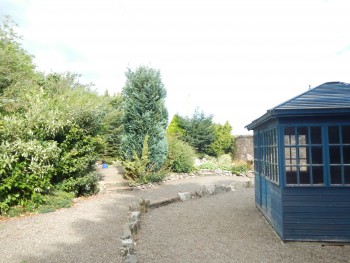- Navigation:
- Back to the Corpus index page
- RSS
Berwick / Bondington St Laurence Parish Church
Berwick-upon-Tweed (Bondington) St Laurence's Churchyard, possible site, Cheviot House, Castle Terrace
- Dedication: St Laurence
- Diocese of St Andrews
- Deanery of Merse
- Parishes of Berwick St Mary and St Lawrence
Summary description
Absorbed into the parish of Berwick St Mary by the fourteenth century, its location is uncertain, but is thought to have been where Cheviot House on Castle Terrace stands.
Historical outline
The original charter by which Roger son of William granted the church of St Laurence of Berwick to the monks of Kelso has not survived, but his gift is recognised in King William’s confirmation of the lands and rights of the abbey made between 1165 and 1173.(1) The grant pre-dated 1160, as possession of the church was confirmed to Kelso by its former abbot Arnold, bishop of St Andrews (1160-1162), who referred to a now lost confirmation by his predecessor, Bishop Robert.(2)
The church was shortly afterwards ceded by Kelso to the monks of Durham, who were confirmed in their possession by Bishop Richard of St Andrews.(3) It appears that by the thirteenth century St Laurence’s had been united with Berwick St Mary’s to form the parish of Bondington, and underwent a subsequent merger in the fourteenth century into the parish of Berwick Holy Trinity.(4)
The parish of Bondington had apparently served the landward district around the burgh.(5) Both of the parishes had been appropriated to the cathedral-priory at Durham in the later twelfth century and the teinds of the conjoined parish were assigned by the monks to the uses of their cell at Coldingham.(6) There are no records of the parish after the thirteenth century, probably having been absorbed into Berwick Holy Trinity as the population of the landward district around the town and in the town itself contracted sharply with the beginnings of the Wars of Independence and the famines and epidemics of the early fourteenth century.
Notes
1. Liber S Marie de Calchou (Bannatyne Club, 1846), no.12 [hereafter Kelso Liber]. The donor is mis-named in I B Cowan, The Parishes of Medieval Scotland (Scottish Record Society, 1967), 17, as Robert son of William.
3. J Raine, The History and Antiquities of North Durham (London, 1852), Appendix, nos ccccliii-cccclvi, dcxliii.
5. Kelso Liber, 467; I B Cowan, The Parishes of Medieval Scotland (Scottish Record Society, 1967), 20.
6. J Raine, The History and Antiquities of North Durham (London, 1852), Appendix, no.dcli; The Correspondence, Inventories, Account Rolls and Law Proceedings of the Priory of Coldingham, ed J Raine (Surtees Society, 1841), cx.
Architectural description
There is some uncertainty as to the location of both the parish of Bondington, and its parish church of St Laurence. However the balance of probabilities is that the parish was a short distance to the north west of Berwick,(1) and that it was later absorbed into the burgh of Berwick, of which it now forms a part.
It has been suggested by one author that the parish of Bondington was served by two churches, dedicated to St Laurence and St Mary.(2) But, while this cannot be ruled out, the church dedicated to St Mary that was initially within Bondington parish may be identifiable with a non-parochial church that was possibly attached to a leper hospital, rather than with the church of that dedication in Berwick itself.(3)
The first reference applicable to the church of St Laurence may be a grant to the Tironensian abbey of Kelso by Robert, son of William, at a date before 1147-50. Some decades later, in 1173x78, Kelso ceded that church to Durham Cathedral Priory. By the fourteenth century the parish of Bondington had been absorbed into that of Berwick Holy Trinity.(4)
The balance of probabilities is that the site of St Laurence’s Church is in the grounds of Cheviot House, a villa on Castle Terrace, which was built in 1868 or 1869. Inadequately recorded excavation carried out at the time of the villa’s construction exposed the foundations of a church that was said to have had a length of 90 feet [27.45 metres], with a tower with dimensions of 25 feet [7.6 metres] square.(5) The provision of a tower gives some support to the idea that this was a parish church rather than a dependent chapel.
The site of the excavated church is assumed to underlay Cheviot House, and further excavation in 2000, in the north-east corner of its garden, located human remains, indicating that the burial ground associated with the church extended so far.(6) Also located was a decorated grave slab that has been dated to the twelfth century,(7) and that is now displayed in the museum in the Ravensdowne Barracks in Berwick.
Notes
1. Eric Cambridge, Tim Gates and Alan Williams, ‘Berwick and Beyond: Medieval religious Establishments on the North Western Margin of Berwick-Upon-Tweed – Problems of Identity and Context’, Archaeologia Aeliana, ser. 5, vol. 29, 2001, pp. 75-78.
2. Ian B. Cowan, The Parishes of Medieval Scotland (Scottish Record Society), 1967, p. 20.
3. Cambridge, Gates and Williams, 2001, pp. 77-78.
4. Cowan, 1967, p. 17; Cambridge, Gates and Williams, 2001, pp. 75-76.
5. J. Scott, A History of Berwick-upon-Tweed and its Corporation, London, 1888, p. 333.
6. Alan Williams, in Cambridge, Gates and Williams, 2001, pp. 64-66.
7. Eric Cambridge, in Cambridge, Gates and Williams, 2001, pp. 66-68.
Map
Images
Click on any thumbnail to open the image gallery and slideshow.
1. Berwick-upon-Tweed (Bondington) St Laurence's Churchyard, possible site, Cheviot House, Castle Terrace
2. Berwick-upon-Tweed (Bondington) St Laurence's Church, possible site, Cheviot House, Castle Terrace
3. Berwick-upon-Tweed (Bondington) St Laurence's Church, grave slab, Cheviot House, Castle Terrace (in Ravensdowne Barracks Museum)



